Oct 16, 2018
What is Pier & Waterfront Solutions?
In a previous article, the discussion was about some of the less widely known projects that Pier & Waterfront Solutions has undertaken. We do much more than most people realize. We have completed everything from decks, wood or metal stairways down cliffs, rip-rap and more. It all falls under the “Solutions” portion of our name.
This article further expands that article.
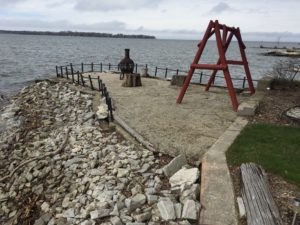
Before
In the “Before” photo above, you can see the condition of the railings, the broken walking surface, and rotted and missing timbers around the perimeter. The owners were concerned that someone would trip and injure themselves. They really wanted to enjoy this area again.
After the appropriate DNR permits were obtained, the work began. EVERYTHING was removed. Permit restrictions required that the general outline be followed.
In this “After” photo, the perimeter was replaced with concrete and decorative rails were added. A new concrete surface was installed as part of the renovations. Solar operated lights were placed on the top of the posts.
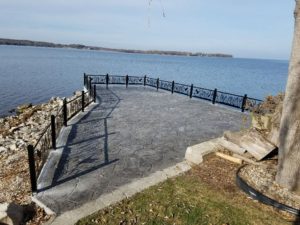
After
The decorative rails were provided in-house as part of the “Solutions” name.
We are always looking for “winter” work. Call Jerry with your ideas.
Where is Pier & Waterfront Solutions?
PWS is located at 7325 St. Hwy 42/57. That’s 1 mile North of County MM (Hwy 42) and 3 miles South of Sturgeon Bay. Look for the Idlewild Road intersection.
Our staff is here year-round to assist you. Don’t forget – Give us a call If you want to see an issue discussed on our site.
Call Jerry at 920-493-4404 or Email Jerry@wisconsinpws.com with any questions.
Sep 18, 2018
Pier & Waterfront Solutions?
SOLUTIONS – What does that word mean in the name – Pier & Waterfront Solutions?
Ok, The name implies that we sell, service, install and remove Piers (docks) and boat lifts. But a lot of people do that. Don’t they?
Yes, they do. But it means a whole lot more when you talk about Pier & Waterfront Solutions. Why? Because we are more than Piers (Docks) and Boat Lifts. What else do we do?
Want to enjoy the outdoors more?
If the answer is YES – Pier & Waterfront Solutions is the right place to be. Just pick up the phone and call us.
Did you know, we also build Decks – attached or freestanding by the water.
We also create some very unusual Stairs to access the shoreline and those Piers and Boat Lifts we talked about.
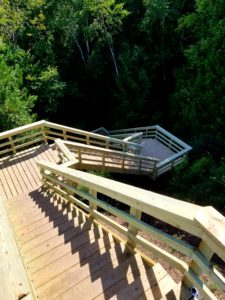
Stairs looking down the cliff
How about this one? Looks simple enough – Right!? A nice straight set of stairs- what’s the big deal?
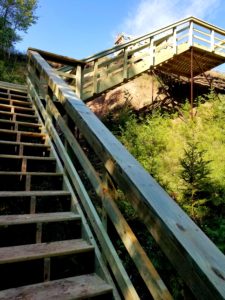
Stairs and deck built over a cliff
Truthfully, anyone can create a set of stairs. But can they do it while suspended over a cliff? How about a deck suspended in the air? Not too shabby. Wait a minute – it’s getting a little more complicated now.
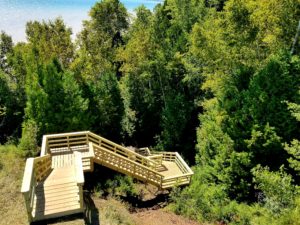
New Stairs down a cliff
The stairs are so long, we had to include platforms on the way down so you can rest. Do those stairs ever quit?
Makes you wonder how they get the docks and lifts down there. But we do!
Now, do you understand why we use “Solutions” in our name?
Where is Pier & Waterfront Solutions?
PWS is located at 7325 St. Hwy 42/57. That’s 1 mile North of County MM (Hwy 42) and 3 miles South of Sturgeon Bay. Look for the Idlewild Road intersection.
Our staff is here year-round to assist you. Don’t forget – Give us a call If you want to see an issue discussed on our site.
Call Jerry at 920-493-4404 or Email Jerry@wisconsinpws.com with any questions.
Sep 11, 2018
Dock and Boat Lift Damage
Dock and boat lift damage was severe in the wake of the Aug 4th, 2017 storm. We were reminded of how important it is to choose the right dock and boat lift for your boat. So many homeowners were reeling thinking about having to replace their entire dock and lift system.
Even ShoreMaster owners had some issue with their dock and boat lift. Fortunately for most of the ShoreMaster owners, the damage looked severe in the early morning hours. Within a day things had settled down and they had minimal damage like missing deck panels. In most cases, these were later recovered downwind of the dock…
Why is a ShoreMaster dock and boat lift so important?
Shoremaster prides itself on premium quality docks and boat lifts. They can stand up to some of the harshest conditions Mother Nature throws at their systems. Their design team considers severe storms like these to provide you with a dock and boat lift system that can last a lifetime. That’s why ShoreMaster has the largest market share on the Bay of Green Bay – they work.
Some dealers screw solid decking down firmly and count on the sheer weight of the system to keep everything in place. ShoreMaster doesn’t do this for a reason. They want the decking to get blown out in a storm as severe as this one.
Yes, you read that correctly – They WANT the decking to get blown out. Why?
Over the years, our experience has shown that when a deck is attached permanently to the frame, the structure takes the brunt of the pressure. All too often, the whole dock becomes a twisted mess as a result. In fact, we have seen ShoreMaster aluminum docks left standing after a storm. At the same time, the steel dock with rigid decking is a twisted mess on both sides of the ShoreMaster dock.
How does Shoremaster solve this problem?
ShoreMaster solves this problem in two ways:
- They now use Glacier Flow Through decking.
- They use a plastic clip on the bottom of the decking.
Glacier Flow Through decking has 42% of the surface open. The open surface allows most of the pressure from a wave to pass thru the deck panels harmlessly.
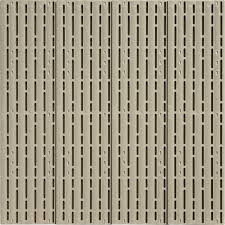
Glacier Flow through PlasticDecking by ShoreMaster
The use of a plastic clip to hold the decking in place means that the decking will stay in place for the average wave or strong winds. With repetitive large waves, the clip is purposely allowed to break-off. The clips will break long before your dock frames become a tangled roller coaster mess like other dock brands.
Speaking of which – Have you tried the roller coaster ride at Bay Beach in Green Bay? While you are there, remember your dock would look like that roller coaster if the clips had not broken.
What about the decking you just lost?
The decking is plastic, has a low surface area, and it will sink to the bottom quickly. During this storm, we were able to recover 99% of the panels downwind. The decking is usually less than 50 feet away at the bottom. We found the panels intact with only broken clips. Isn’t it cheaper to replace some clips than to replace an entire dock frame?
What about the lifts?
ShoreMaster lifts are built to hold up too. ShoreMaster’s all aluminum welded frame, and the premium components protect your watercraft investment under the harshest conditions.
The bolts that hold screw-together boat lifts together can wear out over time, especially with strong wind and wave action. They can give out when you need the protection the most. Welded frames offer durable stability.
How reliable are the lifts?
Recently, customers have come in and told us they couldn’t find a lift with a better-constructed frame. They know that a Square or rectangular frame is much stronger than a round tube anytime. Plus the round tubes are thinner. They look at the wall thickness of the uprights and racks and find that ShoreMaster has the thickest construction in the area.
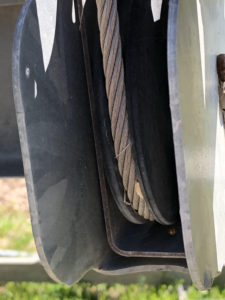
The other guys
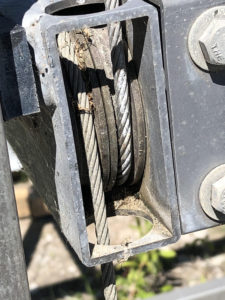
ShoreMaster Heavy wall construction & brass pulleys
Notice the brass pulleys on the ShoreMaster lift versus the plastic pulley on the competitors lift.
These are a few of the design features that ShoreMaster implements to provide their customers with the very best in waterfront equipment. These elements mean that we keep you on the water all summer long.
If you were affected by storm damage on the Bay – or are looking for a premium dock and lift system – Contact your authorized ShoreMaster dealer – Pier & Waterfront Solutions. We will be able to assist you with:
- Service work,
- Replacement parts,
- A new system or
- any other needs you might have for your waterfront.
We even service “those other brands.” Ask us about it.
Where is Pier & Waterfront Solutions?
PWS is located at 7325 St. Hwy 42/57. That’s 1 mile North of County MM (Hwy 42) and 3 miles South of Sturgeon Bay. Look for the Idlewild Road intersection.
Our staff is ready to assist the year round.
Don’t forget – Give us a call If you want to see an issue discussed on our site.
Call Jerry at 920-493-4404 or Email Jerry@wisconsinpws.com with any questions.
Sep 4, 2018
Electrical Shock Drowning ESD – Part 2
Electrical Shock Drowning or ESD was discussed in Part one of this series. Part 2 will get into more detail about this infrequent but deadly situation.
There are two potential failures in a boat’s electrical system that put people on or around the boat at risk. In a properly functioning system, the same amount of AC flows in the hot and neutral wires.
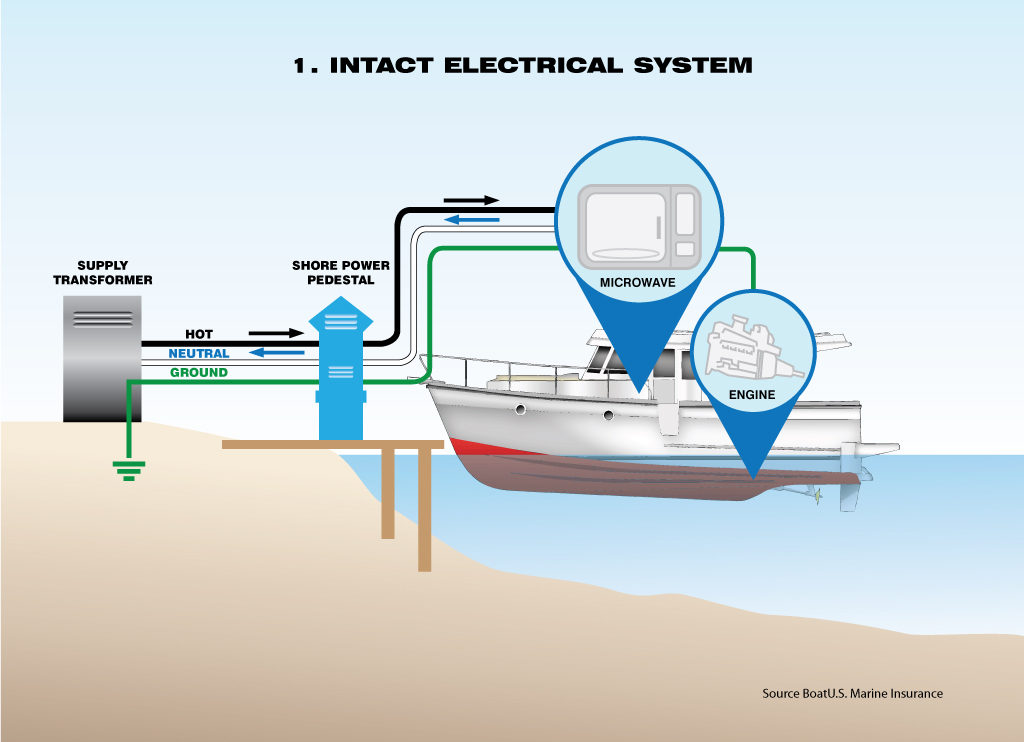
Properly Functioning Circuit
Images courtesy of Boat U.S. http://www.boatus.com/
Happens when a wire or appliance leaks power?
Electricity may “leak” from it’s intended path in these two wires to ground. This condition is called a ground fault. A good example of this is an insulation failure in the wiring of an appliance. Notice the microwave (or any appliance using A.C. power) with the ground fault. This condition will result in a mild electric current in the water which will potentially paralyze a person in the water.
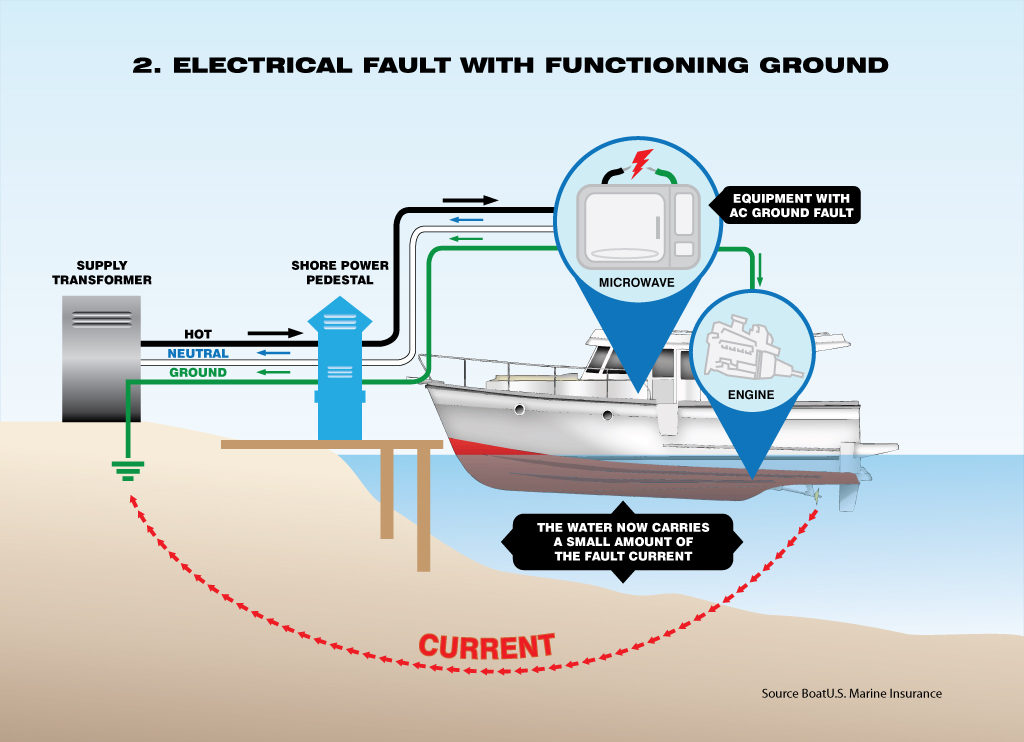
Electrical Fault with Functioning Ground
What happens when there is a leak in the ground wire?
A faulty ground occurs when the grounding path breaks through a loose or broken wire. For instance, a shore power cord ground wire may fail due to constant motion and stress.
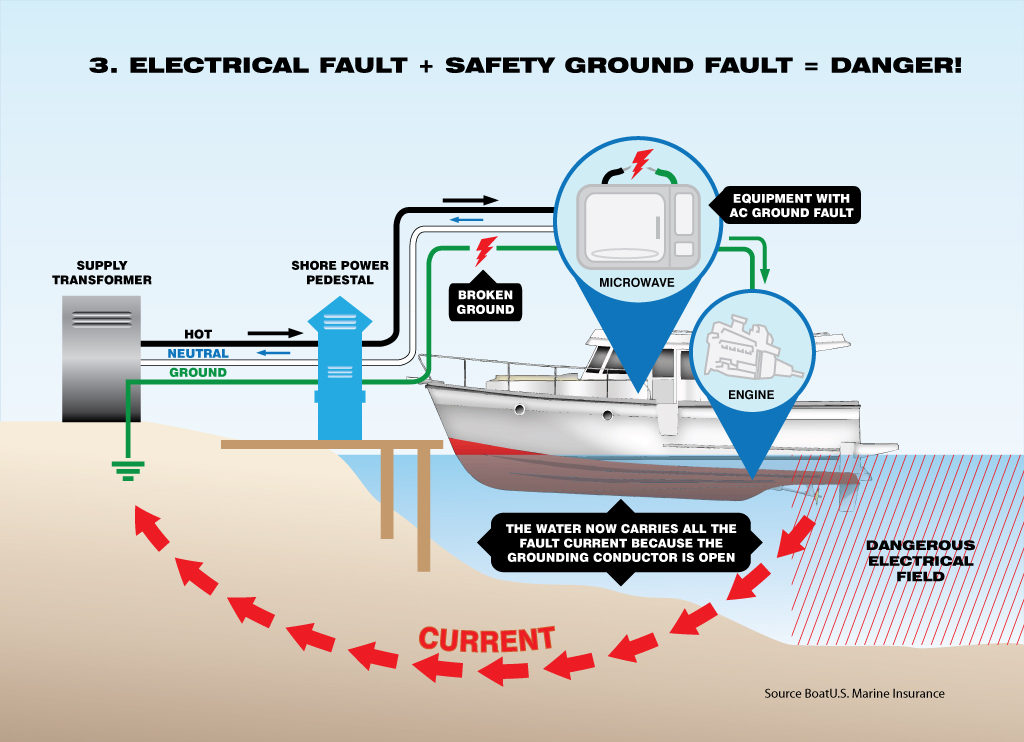
Electrical Fault + safety ground fault = Danger
When these two conditions occur at the same time, the results may be tragic. The combination of a ground fault and a faulty ground results in metal parts in the boat and under water becoming energized. People on board the boat are likely to receive a shock from touching energized metal parts.
When this happens, a person swimming near the boat will be electrocuted immediately.
A Coast Guard sponsored study showed numerous instances of electrical leakage causing drowning or potential drowning even though the shock did not result in death.
What can prevent this from happening?
ELCIs (Equipment Leakage Circuit Interrupters) and the more familiar GFCI (Ground Fault Circuit Interrupters) are part of a larger family of devices. These devices measure current flow in the hot and neutral wires. They immediately switch the electricity off when an imbalance of current flow is detected. ELCIs and GFCIs that are also Residual Current Circuit Breakers (RCBO) provide overcurrent tripping protection also.
GFCIs are used as branch circuit ground fault protection at the 5mA threshold in wet environments. GFCIs protect against flaws in devices plugged into them but offer no protection from the danger of a failing hard-wired appliance, such as a water heater or cooktop.
An ELCI provides additional whole-boat protection. Installed as required within 10′ of the shore power inlet, an ELCI provides 30mA ground fault protection for the entire AC shore power system beyond the ELCI. ABYC regulations still require the use of GFCIs in environments described above.
Thanks to Blue Sea Systems for the information in this article. For more on how to protect yourself and your loved ones from electrical shock drowning, go to the BoatU.S Electric Shock Drowning Resource Center.
Where is PWS?
PWS is located in the center of Door County at 7325 St Hwy 57. It is located 1 mile North of County MM (Hwy 42) and South of Sturgeon Bay. Look for the intersection of Idlewild Road.
Want us to address a dock or boat lift topic for you? Feel free to give us a call.
Call Jerry at 920-493-4404 or Email Jerry@wisconsinpws.com for more information.
Aug 28, 2018
ESD: What is it? Part 1 of 2
ESD, also known as Electric Shock Drowning, is a form of drowning caused by an electric current in the water. Where does the electric current originate? It could be your boat, a malfunctioning charger or lighting system. More on this in Part 2 of this series.
I have a fiberglass boat hull – that should protect swimmers – Right??
Yes, but you also have a motor with a metal prop in the water. As a result, this exposes people in the area of the boat to an electrical shock. The shock is greater as they get closer to the source of the problem.
Why is ESD even more dangerous in freshwater?
In freshwater, electrical current passes through the body paralyzing the body muscles. The strongest, most experienced swimmer in the world will not be able to swim through the current field if this happens.
Is there a warning of ESD?
Yes, there is:
- The victim will feel tingling, numbness, pain, and paralysis. That is the first sign of a problem. The closer they get to the source of the current the stronger the sensations will be – and the more paralyzed they will become.
- Initially, the victim will be able to shout, but if they unknowingly try to swim towards the electrical source, this ability will cease as they become paralyzed.
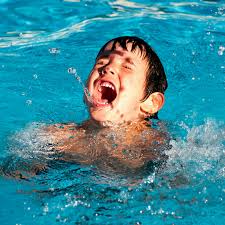
Still able to communicate
- The ability to “shout” more than once is critical. It is the difference between an ESD, an electrocution victim, and a drowning victim. An electrocution victim may not be able to shout at all. A drowning victim can only shout once or twice before his/her lungs fill with water.
- Typically, if the victim of ESD is not close to the source, he can shout and tell you what is happening. A drowning victim cannot yell as their lungs fill with water.
- Many times the ESD victim looks distressed and not as playful as usual. The muscles will no longer function as normal.
- The situation may turn into drowning once the victim begins to get water in their lungs.
How about Electrocution
- A possible victim will be able to scream, usually only once. The victim’s muscles will cease to function almost immediately.
- There will be a sudden cessation of all activity
- The victim usually rolls on their back with their face out of the water and is not responding if wearing flotation.
- If not wearing flotation, they will likely roll onto their face.
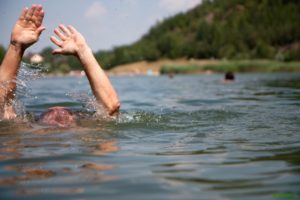
A swimmer in distress
Drowning
- The victim cannot speak or shout
• Reflexive “ladder climbing” with their arms even for an experienced swimmer.
• Looks “playful.”
• Lasts ~60 seconds with an adult and as little as 20 seconds with a child
• Slips below surface
What to do if you suspect an ESD situation
- Keep everyone out of the water – and if they are already in the water – DO NOT allow them to swim back to the dock unless the sensation gets stronger while swimming away from the dock or boat. Remember, the source may be a nearby dock, pump or boat.
- Try to get others in the area to swim away from your dock at least 100 yards and then go to the shore. The electrical current is stronger nearest the source and dissipates as you get away from it.
- Resist the natural impulse to jump into the water to help. You will become a victim yourself. Do NOT jump into the water. Use the Reach, Throw, Row, DON’T GO technique below.
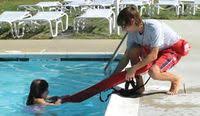
The safest way to help someone in distress
- Protect yourself by using an oar, a float or other non-conducting material to pull the swimmer to safety once the electrical source is shut off See the caption to the right.
- Immediately disconnect all power.
- Take the victim to the hospital to make sure there are no lingering effects that could be dangerous.
In General

Performing CPR if needed
- ESD victims are good candidates for successful Cardiopulmonary Resuscitation (CPR).
- Learn to perform CPR and maintain your training.
- To retrieve a person in the water, reach, throw, and row, but don’t go.
- Make sure your children understand the importance of not swimming anywhere there could be electricity. Don’t let them roughhouse on docks. Tell them what to do if they feel a tingling or shock in the water (see below).
I want to test for current myself. Can I do it?
Yes, with my digital voltmeter, put the negative lead to a ground, drop the positive lead into the water, if the needle moves, even slightly – you may have AC Voltage in the water. Having an electrician do the testing is the best way
- Have your boat tested once a year to see if it is leaking electricity, or buy a clamp meter and test it yourself. If you find any problems, have your boat inspected by a qualified electrician.
- Have a qualified ABYC electrician install an ELCI on your boat (refer them to the ABYC E-11 Standard) or use an ELCI in the shore power cord. As an alternative, install an isolation transformer on the boat.
- Test the GFCI/ELCI at least once a month or per the manufacturer’s specifications.
- DO NOT do your own 120-volt AC electrical work on a boat or hire an electrician who is not familiar with ABYC standards to do it. Many of the problems that lead to electrical faults result from the differences between shore and boat electrical systems and standards.
- NEVER dive from your boat to work on underwater fittings when it is plugged into shore power.
- DO NOT use common household extension cords for providing shore power to your boat. Use, and encourage other boaters to use shore power cords built to UL standards. Make sure the connections DO NOT touch the water.
If You Have A Private Dock
- NEVER swim within 100 yards of ANY dock using electrical power!
- If you have not electrified your dock or put an AC system on your boat, weigh the risks carefully before doing so.
- Need electricity on your dock – hire a licensed electrician and make sure the wiring meets the requirements in NFPA 303 and NEC 555. If your dock is already wired, hire an electrician to check that it was done properly. Docks are exposed to the elements, their electrical systems should be inspected at least once a year.
- If you normally run a power cord from your house or garage to charge your batteries, make sure the outlet has a GFCI and include an ELCI somewhere in the shore power cord. See part 2 of this series.
- NEVER swim off your dock without shutting down all shore power to the boat and the dock.
- Even if you adhere to all of these rules, nearby docks can still present a shock hazard. Educate your neighbors and work together with them to make the waterfront safe.
What if…
Someone you were with fell out of a boat without their life jacket – Would you know what to do?
- REACH: Hold on to the dock or your boat and reach your hand, a boat oar, a fishing pole, or whatever you have nearby, to the person. Many times these people have a fear of drowning and they will pull you under. Do not touch metal yourself.
- THROW: If you can’t reach far enough, toss things that float for the person to grab.
- ROW: If you’re in a boat, use the oars to move the boat closer to the person in the water, or call out to a nearby boat for help. Don’t use the boat’s motor close to a person in the water; they could be injured by the propeller
- DON’T GO: Don’t go into the water You will become a victim yourself. Call out for help. Never use a metal ladder or stairs to enter the water when there is an electrical problem
Be careful reaching from the boat or dock – If you are touching metal, you may be a path to ground yourself.
In part two of this series, we will explain more about the GFCI and ELCI.
Where is PWS?
PWS is located in the center of Door County at 7325 St Hwy 57. It is located 1 mile North of County MM (Hwy 42) and South of Sturgeon Bay. Look for the intersection of Idlewild Road.
Want us to address a dock or boat lift topic for you? Feel free to give us a call.
Call Jerry at 920-493-4404 or Email Jerry@wisconsinpws.com for more information.




















